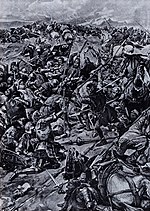Battle of Chlumec
1126 in EuropeBattles involving BohemiaBattles involving the Holy Roman EmpireBattles of the Middle AgesConflicts in 1126 ... and 1 more
Lothair III, Holy Roman Emperor

See Battle at Chlumec (1040) for a possible earlier battle, and Battle of Kulm for the Napoleonic battle.The Battle of Chlumec was the culmination of a 12th-century war of succession in the Duchy of Bohemia. It occurred on 18 February 1126 in the vicinity of the village of Chlumec (German: Kulm) near Chabařovice on the southern slopes of the Eastern Ore Mountains. The Bohemian forces led by Duke Soběslav I defeated an Imperial contingent of troops under King Lothair III of Germany and his Moravian ally Duke Otto II the Black.
Excerpt from the Wikipedia article Battle of Chlumec (License: CC BY-SA 3.0, Authors, Images).Battle of Chlumec
25350, okres Ústí nad Labem
Geographical coordinates (GPS) Address Nearby Places Show on map
Geographical coordinates (GPS)
| Latitude | Longitude |
|---|---|
| N 50.666666666667 ° | E 13.933333333333 ° |
Address
25350
403 17 okres Ústí nad Labem, Chabařovice
Czechia
Open on Google Maps











